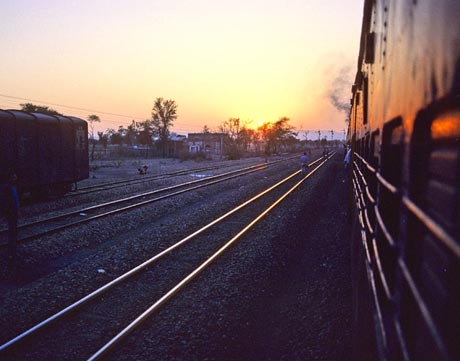
What better way to explore India than by rail? Make the most of your trip with these route ideas
DURATION: One week
Mumbai – Gokarna – Udupi – Kochi – Kollam – Trivandrum – Kanyakumari
The epic journey south along the western coast of India became possible only in 1998 after the opening of the 741km Konkan Railway between Mumbai and Mangalore.
The fastest train is the twice-weekly Trivandrum Rajdhani Express, which takes in the Konkan Railway as part of its 1,537km Delhi-Trivandrum haul. Goa’s coast, Gokarna’s temples and the pilgrimage site of Udupi are worth stopping at before you reach Mangalore.
Heading into Kerala, the section between Mangalore and Kuttipuram is much closer to the sea, passing through the former French enclave of Mahé. Kochi (Cochin), and particularly Fort Kochi, is probably the best choice if you’re only making a single stop; it has many interesting sights including a Portuguese palace and a synagogue. Kollam (Quilon) is a good launching point for a trip into Kerala’s famous backwaters.
Kerala’s capital, Trivandrum (Thiruvananthapuram), remains a pleasant city with a spectacular 18th-century temple boasting 368 carved granite pillars. From here it is less than three hours to Kanyakumari (Cape Comorin), the most southerly point on Indian Railways – and the southern tip of the country.
DURATION: One week
Delhi – Rampur – Lucknow – Varanasi – Kolkata
The fastest train route between Delhi and Kolkata is via Allahabad, but the more northerly main line offers more enticing reasons to break the journey.
Few visit Rampur, but it has an impressive palace and fort, which hosted the then Viceroy, Lord Reading, in 1923.
Several days are needed to see the principal sights of Lucknow, famous for the 87-day siege of the Residency during the Indian Mutiny. The shell remains as a memorial to that bitter conflict. There are many palaces, tombs and museums as well as La Martinière College, one of India’s most famous schools.
Don’t miss a stop at the eerily intriguing waterfront ghats (steps) at Varanasi, best seen from a boat on the Ganges at dawn; the sight of huge numbers of Hindus praying, washing and being cremated is memorable. The holy city also has many temples and a 17th-century mosque.
DURATION: Ten to 14 days
Delhi – Agra – Bharatpur – Jaipur – Ajmer – Delhi
Expand on the ‘Golden Triangle’ of Delhi, Agra and Jaipur by adding on some of the slightly less-visited sights of Rajasthan.
It is only three hours on the train from Delhi to Agra, from where it’s an hour to Bharatpur Junction for Keoladeo Ghana, one of the country’s finest national parks and bird sanctuaries, best visited between November and February.
A direct train takes you on to Rajasthan’s capital at Jaipur, where you will want to spend at least three or four days to do justice to the pink palaces, museums, bazaars and havelis (private houses), and the fort at nearby Amber.
Take another direct train to Ajmer; besides one of India’s finest Jain temples and the tomb of a Sufi saint – the second-holiest Muslim site after Mecca – Ajmer is home to the ‘Eton of Rajputana’, Mayo College, in an imposing Indo-Saracenic building dating from 1873. It’s a seven-hour journey from Ajmer back to Delhi.
DURATION: One week
Chennai – Tiruchirappalli – Srirangam – Madurai – Rameswaram
Some of India’s finest temples lie to the south of Chennai, and are well served by train. A little over five hours from Chennai is Tiruchirappalli (Trichy), base for visits to the temples at Srirangam, where seven concentric walled courtyards are entered through magnificent gateways.
Further south is Madurai, a vibrant centre of Tamil culture with some breathtaking temples and palaces: the Sri Meenakshi temple contains a 16th-century hall with 985 intricately carved columns. Try to catch one of the evening musical performances. The city’s Gandhi Museum traces the movement for independence as well as the great man’s life, with memorabilia that includes the dhoti (long loincloth) he was wearing when he was murdered.
From Madurai take a train east to the coast at Rameswaram; don’t miss the Ramalingesvara, which has a 200m corridor lined with decorated pillars.
DURATION: Four to seven days
Delhi – Ambala – Chandigarh – Kalka – Shimla
If time is short and you want to take one train trip from Delhi, the journey north to Shimla is the one to pick. The mountain air and tranquil pace of the ‘summer capital of the Raj’ could not be more different from the pollution and bustle of the capital. And there are good reasons to pause en route if time permits.
Head north on the Kalka Mail through Ambala, where one of the largest cantonment areas of the Raj was laid out from 1843; sadly the gothic St John’s Cathedral of 1857 was reduced to a shell during the Indo-Pakistan war. Anyone interested in modern architecture will also want to stop off at Chandigarh, the capital of the Punjab. Its plan, and many of its main buildings, were designed by Le Corbusier.
At Kalka, switch to the narrow-gauge train. From here the line describes an endless series of S-bends to wind its way to Shimla, through 107 tunnels and over 869 bridges and viaducts. Indeed, the railway was designated a World Heritage site in 2008. Shimla itself was created in that curious mix of styles peculiar to hill stations – wander between cottage ornée-type villas, Highland shooting lodges and corrugated-iron pre-fabs.